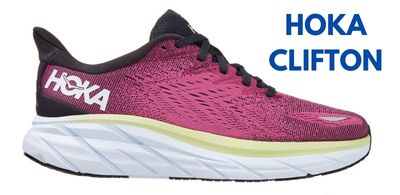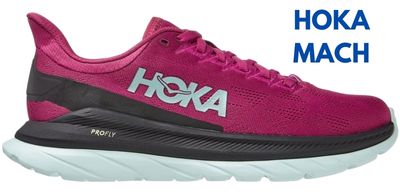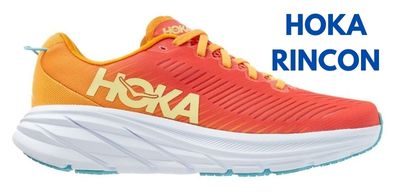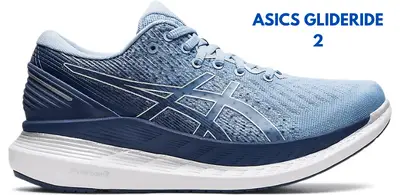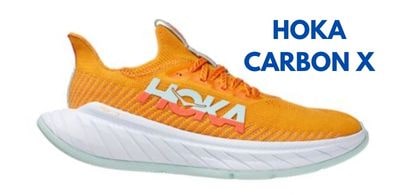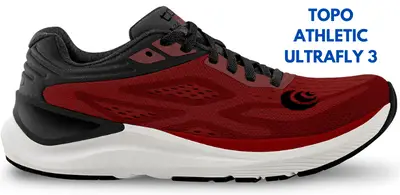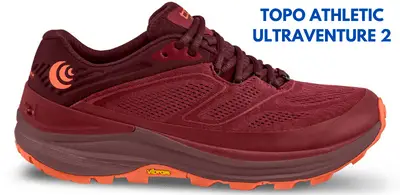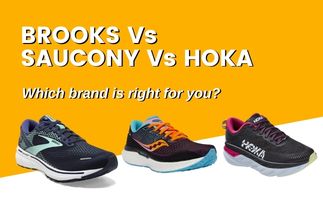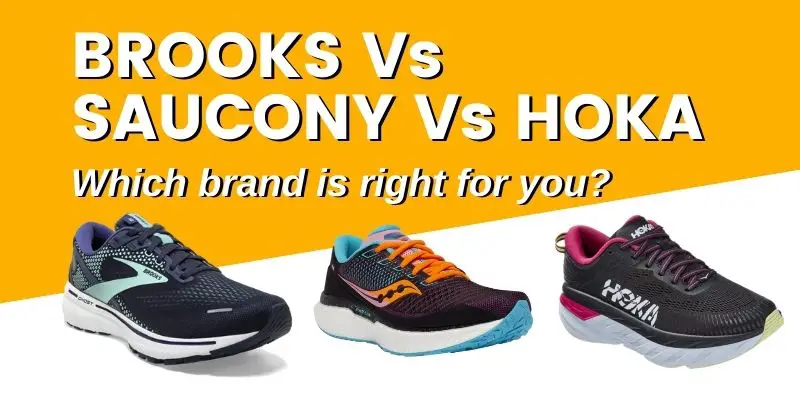![10 Best Running Shoes For Retrocalcaneal Bursitis [2022]](https://bestplaygear.com/wp-content/uploads/2022/06/Top-Running-Shoes-For-Retrocalcaneal-Bursitis.jpg)
10 Best Running Shoes For Retrocalcaneal Bursitis [2022]
[aff_disclosure]
Retrocalcaneal bursitis is a painful condition and can develop in anybody. It is the inflammation or irritation of the fluid-filled sack in between the heel bone and the Achilles Tendon.
People who run a lot or have increased their exercise intensity suddenly are at more risk of developing such a condition. One of the main ways to stay comfortable with such a condition is to have your heel elevated a bit. This releases any pressures on your Achilles Tendons.
So, a proper running shoe for this condition should have a higher heel stack, a well-cushioned heel area, and should not be narrow/tight fitting.
One of the running shoes that fit all these criteria is ASICS Gel-Nimbus 24. It has an overall roomy fit, a heel-to-toe drop of 13mm for women and 10mm for men, and has a good amount of padding in the heel, collar, and tongue area.
Also, below we have prepared a list of 10 different running shoes that will suit different types of runners and all have the required features to deal with retrocalcaneal bursitis.
Without further ado, let’s check out the list of best running shoes for retrocalcaneal bursitis…
10 Top Running Shoes For Retrocalcaneal Bursitis
1. ASICS Gel Nimbus 24
2. ASICS Novablast 2
3. Brooks Launch GTS 9
4. New Balance Fresh Foam X 1080v12
5. Salomon SpeedCross 5
6. ON Cloudrunner
7. Nike ZoomX Invincible Run Flyknit 2
8. Brooks Hyperion Elite 3
9. Mizuno Wave Inspire 18
10. Saucony Endorphin Speed 2

Table of Contents
Best Running Shoes For Rectocalcaneal BursitisBest Rectocalcaneal Bursitis Running Shoes (Detailed Review)
ASICS Gel Nimbus 24

Asics Gel-Nimbus 24 is the first running shoe on our list for retrocalcaneal bursitis. They are one of the most comfortable running shoes around and fit into the criteria of heel bursitis perfectly.
It is not a narrow shoe and is available in different widths as well for both women and men. Also, this shoe has a high heel drop. For this shoe, the heel drop is different for both genders.
However, irrespective of that, both the drop qualify for what is required for retrocalcaneal bursitis. For this, you would need a running shoe that can keep your heel slightly elevated.
Anything above 8mm is good for this purpose. Asics Gel-Nimbus has a heel-to-toe drop of 10mm for the men’s version and 13mm for the women’s version.
Also, the fitting of the heel is not snug and has plenty of room. This is important for a person suffering from heel bursitis as this can make the whole running experience more uncomfortable. It can also aggravate the condition.
The overall cushioning of the heel area is good and smooth. This doesn’t put much pressure on your heels. Also, being smooth, you will not have to deal with problems like blisters.
The padding of the collar and the tongue also keeps the ankle area more stable and provides you with a more comfortable running experience.
The cushioning of Asics Gel-Nimbus is also excellent. It has gel cushioning and FlyteFoam in its midsole. This makes it very good at shock-absorption and this also keeps your heel and ankle area comfortable.
Pros.
- Good fit and style.
- No breaking-in period is needed.
- Available in different widths.
- Higher drop is good for issues in the ankle, heels, or Achilles Tendon area.
Cons
- May show early signs of wear and tear.
ASICS Novablast 2
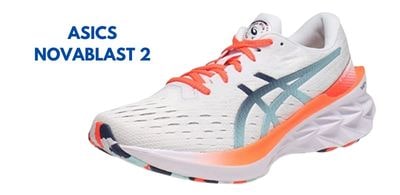
ASICS Novablast 2 is a very comfortable running shoe. It has maximal cushioning that provides exceptional impact absorption.
One of the best things about Asics Novablast is that it has a heel stabilizer. It provides additional support to the foot by stabilizing the heel. This provides you with a more balanced ride. In other words, you will have lesser stress on your ankles and heels which is a good thing, if you are suffering from retrocalcaneal bursitis.
The heel drop of Asics Novablast is not as high as Asics Gel-Nimbus, however, it is still within the required minimum limit. The drop of Asics Novablast is 8mm for both men’s and women’s running shoes. This creates the required heel elevation and takes offload from Achilles’ tendons.
This is a good thing as if you have developed heel bursitis, then there may be a higher chance that you have got it due to a sudden increase in your activity or running levels.
If that is the case, then not only your heel bursae but also your Achilles’s tendons are at a higher risk of developing an injury. In other words, you are at a much higher risk of developing Achilles Tendonitis.
Apart from the 8mm drop and heel stabilization, the width of Asics Novablast is also good. It has a decent width from toe to heel and you will not feel snug while wearing this shoe.
Having a snug fit only increases the chances of worsening your bursitis. However, having a widish fit can make you feel more comfortable and you will be able to tackle your heel bursitis better.
Apart from being a supportive shoe for your bursitis, Asics Novablast is a great running shoe. It has a very grippy and wear-resistant outsole that will last for a long time.
The FlyteFoam Blast midsole is comfortable and lightweight. It is bouncy and highly responsive and provides you with a very efficient ride.
Pros
- Very stylish.
- No breaking-in period is needed.
- Excellent shock absorption.
- Great for ankle strain and Achilles weakness.
Cons
- Toe-box depth is not good.
Brooks Launch GTS 9
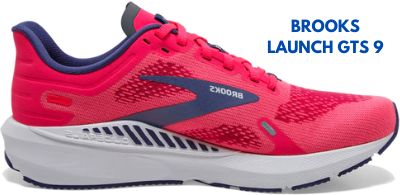
This is another favorite shoe of mine. Brooks Launch GTS is a ‘support’ running shoe. It comes with Brooks proprietary GuideRails and it keeps your knees in the line of motion.
This is a running shoe for overpronating runners. This is the first shoe in this category that is a stable running shoe. The shoes that are provided above are of neutral category or support mild underpronation.
This is a very comfortable running shoe that is great for running shorter distances that are up to 10K. Also, they are a great shoe for walking, if you want to use them for that.
The drop of Brooks Launch GTS is 10mm. This is around 2mm more than the lowest drop permissible for a runner with retrocalcaneal bursitis.
Due to this drop, the pressure on your Achilles’s tendons and ankle joints is reduced. This will make your running with bursitis a bit more comfortable and you will also experience the pain lesser. Also, the extended pull tab will provide additional support to the Achilles area.
The heel area is padded well. It is smooth and devoid of any stitches. This makes it comfortable to wear even with bursitis. However, what I would have liked more was for the tongue to be more padded.
The tongue is like a neoprene tongue and doesn’t have much padding. It is not uncomfortable, but a padded one would have made a slight difference I feel.
The width of Brooks Launch GTS is good and is also available in two different widths, the medium width, and the wide width. This makes the fitting of the shoe very comfortable and will not bite into your feet.
The same goes for the heel area. This also has a decent width and will not have a hard grip on your heels.
The outsole of Brooks Launch GTS is made of high abrasive rubber and is very durable. It covers almost the entire sole and provides you with a very stable ride.
This is a very lightweight shoe and has a very responsive midsole. This adds a bit of zing to your feet and will make your ride that much peppier.
Pros
- Lightweight.
- Affordable.
- Good for people with a bad back.
- Excellent for foot issues like metatarsalgia and bunions.
Cons
- Would have preferred a thicker tongue.
- A slight more softness would have been better.
New Balance Fresh Foam X 1080v12
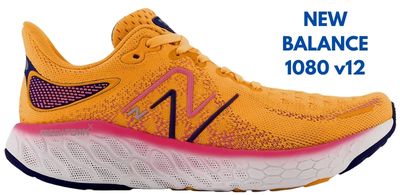
New Balance Fresh Foam X 1080v12 is one of the cushiest running shoes around. The Fresh Foam X is softer, lighter, and more resilient than the Fresh Foam.
Also, it is great for running longer distances and is very stylish to look at…
Now I’m digressing…
How is New Balance 1080 beneficial for your retrocalcaneal bursitis?
Let’s find out…
Let’s start with one of the most important aspects of this shoe that will help you with your heel bursitis…It is the heel drop of this shoe.
New Balance 1080 has a heel drop of 8mm which is a good drop for retrocalcaneal bursitis. As mentioned earlier, this bursitis can develop due to increased activities.
This can also develop due to inflexibility of the foot. In that case, having a higher drop releases some of the stress from the Achilles tendons and other areas of the foot, giving you some relief from the bursitis pain.
Another important aspect of New Balance 1080 is the width of the shoe. First of all the overall fit of this shoe is wideish. Also, it is available in different widths making it comfortable for runners with different foot widths.
A snug fit especially in the heel area causes bursitis to aggravate and your pain may increase a lot. Having a decent width in the heels will lead you to have a more comfortable fit and a much more pleasurable running experience, even with bursitis.
The heel area is smooth and well-padded and is great for runners with bursitis. This will provide additional cushioning to the heel area and will keep you comfortable.
Also, the tongue of the New Balance 1080 is also well padded. This helps to keep the ankle joint stable and will help to reduce the pain to some extent.
The outsole of the shoe is made from durable rubber which enhances the lifespan of the shoe. This also keeps you stable on the roads while you are running. This has a good grip on surfaces whether wet or dry. The jacquard mesh is breathable and provides you with excellent stretch and comfort.
Pros
- Very stylish.
- No breaking-in period is needed.
- Available in multiple widths.
- Excellent cushioning.
- Lightweight.
- Good absorption.
Cons
- Heavy.
- Expensive.
Related: New Balance 1080v12 Vs 1080v11: What Changed?
Salomon SpeedCross 5
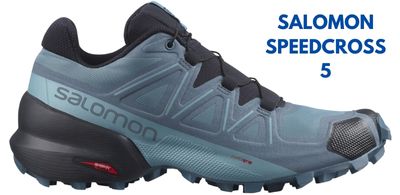
Until now, the running shoes that we have presented for retrocalcaneal bursitis are all road running shoes. But it is not that only road runners suffer from this foot problem…trail runners also have to deal with similar problems…
This is why we thought to include a trail running shoe into the list and what better could be than Salomon SpeedCross 5. This is one of the most popular trails running shoes that have been around for some time.
But how does it helps with bursitis?
The drop of Salomon SpeedCross is 10mm. This is a very important feature of this shoe as it is one of the primary requirements for this foot condition.
This essentially elevates the heel taking off pressure from the Achilles and the calf area. This helps you to run more comfortably even with the bursitis pain.
Now let’s look at the heel area of the shoe itself. The fit of the heel is comfortable. It is not hugely wide, but comfortable and doesn’t create a pinch grip on your heels.
This makes it comfortable for runners with heel bursitis as a snug fit will make you more uncomfortable. Also, the added pressure from the snug fit will make the heel bursitis worse.
The heel area of this shoe is well padded. It is comfortable and smooth and will not rub against your feet to create blisters. It is also an additional layer that will act as an added protection to your heel area.
The tongue and also well padded providing additional stability to the ankle area. This may seem a minor thing, but this added cushioning actually makes your life that bit easier.
I only have one complaint with this shoe. It is not good for runners who have wide feet. It has a bit of a snug toe box that may not be very comfortable for long runs.
Pros
- Excellent grip on the trails.
- No breaking-in period is needed.
- Long-lasting.
- Shock absorbing.
Cons
- Snug toe-box.
ON Cloudrunner

ON Cloudrunner is a very well-built running shoe that is good with cushioning and is great for longish distances. The fit is comfortable and the toe-box is not as pointed as the New Balance 1080.
One thing that I love about ON Cloudrunner, apart from its performance is its looks. It looks more like a lifestyle sneaker than a running shoe. So, you can comfortably wear them even for casual outings.
These shoes are very comfortable even on the inside which has a comfortable padding in the right places and a smooth finish devoid of any stitches and roughness.
Now let’s check if it has the required features of a running shoe suitable for retrocalcaneal bursitis…
First of all, the drop of ON Cloudrunner is around 9mm. This is just above the requirement of 8mm for heel bursitis. Also, not only does it have a heel elevation, but it is also great from a heel cushioning perspective. The cushioning of the heel is soft, impact-absorbent, and is great for heel strikers.
Also, this elevation is great if you have stiff calf muscles, and will take some load off them.
The cushioning at the heels is also good…it is soft and firm and is great for providing additional support to the heel area. Also, the fitting of the heel is not snug and is good for runners with heel bursitis.
If the fit of the heel was snug, it would have increased the discomfort that you already have or may have aggravated the condition.
Also, the collar and the tongue have a decent amount of padding and the collar area has a notch at the Achillis portion. This improves the overall Achilles support which will further enhance the comfort.
Pros
- Excellent style.
- No breaking-in period is needed.
- Widish fit.
- Excellent for Achilles problem.
Cons
- Not good for long toes.
Nike ZoomX Invincible Run Flyknit 2
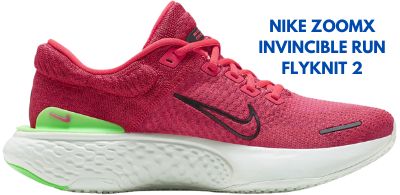
Nike ZoomX Invincible Run Flyknit 2 is a comparative newer model than the other ones like Nike Pegasus. However, these shoes have excellent cushioning and are in the maximal cushioning category.
Also, if you observe the midsole of Nike ZoomX Invincible Run, you will find that the midsole is a bit protruded backward like Hoka Clifton EDGE.
This improves the cushioning and impact resistance for heel strikers, who are more at risk of heel bursitis. Also, you will have a more comfortable ride wearing this amount of cushioning.
Although it may not show, the drop of Nike ZoomX Invincible Run is around 9mm. It is a good heel drop if you are suffering heel bursitis. This will help you take the pressure off that area and the Achilles and will make you have a more comfortable running experience.
The overall fit of this shoe is very comfortable. It is wideish and will not press down on any part of your foot, especially at the heels. The heel area having a good width doesn’t put additional pressure on the heels.
This is good as more pressure on your bursae will only increase the discomfort and will make you very uncomfortable.
Also, the tongue and the collar are well-padded to provide you with added ankle stability. The tongue is an oversized one that spreads on the top of your foot well and provides a gentle grip for a stable experience.
The outsole of Invincible Run is a rubberized midsole that is grippy and long-lasting. However, in more wear and tear, prone areas like the tip of the forefoot or the edge of the heels have a more durable rubber. This improves the durability of the shoe.
Overall, you will have a comfortable running experience while running in Nike ZoomX Invincible Run, even if you have heel bursitis.
Pros
- Good fit and style.
- Additional heel protection.
- Comfortable fit.
- Maximal cushioning.
Cons
- Heavy.
- Expensive.
Brooks Hyperion Elite 3
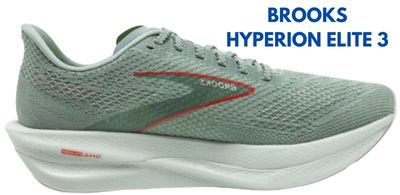
Brooks Hyperion Elite 3 is a running shoe that has a carbon fiber plate in its midsole. This improves the responsiveness of this shoe. Also, having a nitrogen-infused midsole is excellent for longer rides as it makes this shoe very lightweight.
The drop of Brooks Hyperion Elite is around 8mm. This is a good heel drop for heel bursitis as I’ve already mentioned earlier.
The heel is also decent as it doesn’t give you a snug fit. However, where it lacks is the padding in the collar and tongue area. Although the amount of padding that is present is not very bad, I would have preferred a bit more like that in the other Brooks shoes.
Also, I love the fit of Brooks Hyperion Elite as it has a wideish fit and will not bite into your feet. It has excellent wiggle space and a very comfortable and relaxed fit.
The outsole of Hyperion Elite is also very grippy and has durable rubber in the high wear and tear-prone areas.
Also, this is a very lightweight shoe and will not bog you down with your weight.
This is a unisex running shoe that is excellent for all neutral runners and is good for casual runs or long-distance running.
Pros
- Good fit and style.
- No breaking-in period is needed.
- Unisex design.
- Maximal cushioning.
Cons
- Available in only one width.
- Not enough padding on the tongue and collar.
Mizuno Wave Inspire 18
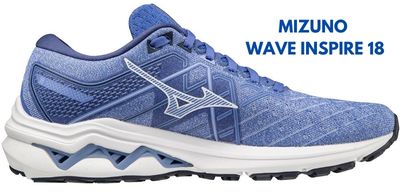
Mizuno Wave Inspire 18 is a stability running shoe. It is great for runners with overpronation and will keep your foot motion in check. It is a no-frills attached running shoe and is simple, comfortable, and lightweight.
This is one of the best qualities that I like about Mizuno…they have streamlined the shoe so much that it has only the things that will contribute to your performance. If it doesn’t then it is not present in this shoe.
The cushioning level of this shoe is also very good. It has those famous Mizuno waves that add an extra bit of peppiness under your heels. This is good for runners suffering from heel bursitis as the more cushioning you have the better.
Also, the drop of Mizuno Wave Inspire is around 12mm which is similar to that of Brooks Ghost or Adrenaline and provides you with a good amount of elevation so that your Achilles are not overloaded.
The fit of the heel is wideish and doesn’t pinch. Also, it is not so wide that it will provide you with a very bad fit and heel slip…
The cushioning of the heel area, the collar, and the tongue are also good and will provide you with additional stability.
The outsole of Mizuno Wave Inspire has durable rubber in the high wear and tear areas. This makes it durable and has an excellent grip. It will not make you unstable even on the wetter ground and is excellent for long-distance running as well.
Also, the upper has engineered mesh and is breathable, and will provide you with a cool and comfortable ride.
Pros
- Lightweight.
- No breaking-in period is needed.
- Good for runners with overpronation.
- Good for low arches.
Cons
- Toe-box could have been wider.
- A notch in the Achilles area would have been better.
Saucony Endorphin Speed 2
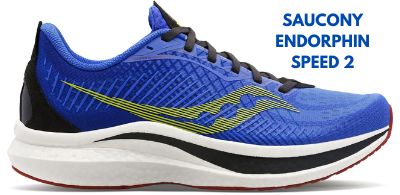
Saucony Endorphin Speed 2 is the last but not the least running shoe in our list of heel bursitis running shoes. It is excellent in providing comfort and is great for speed and performance.
Instead of a carbon plate, Endorphin Speed has a nylon plate that improves the snappiness of the sole. This provides you with a similar experience to the carbon plate shoe and is great for responsiveness and performance.
The drop of Saucony Endorphin Speed is around 8mm, which is the acceptable heel drop for anyone suffering from heel bursitis. The main reason for any heel drop is to take away the discomfort from the Achilles and the heel area.
However, a lower drop or a zero drop is not as effective and will add additional load on these areas. Having a drop of at least 8mm solves this problem and Saucony Endorphin Speed has that.
The heel and tongue area of Saucony Endorphin Speed has decent padding and will keep your ankle stable and will provide you with a decent amount of cushioning.
However, the amount of cushioning in those areas could have been better, this is what I felt. Also, the overall width of the shoe is decent. The heel area doesn’t have a suffocating grip on the heels and is great for runners with retrocalcaneal bursitis.
Overall it is a good shoe that will provide you with a decent performance.
Pros
- Cushy and responsive.
- True-to-size.
- Good for any distance running.
- Wideish fit.
Cons
- Bulky.
- The collar area could have used more cushioning.
FAQs
Can I run with retrocalcaneal bursitis?
You should not run with retrocalcaneal bursitis. If you are having pain, then it is better to stop all activities that will put pressure on the heel like walking, running, jumping, etc, until the pain subsides.
But what exactly is retrocalcaneal bursitis?
A bursa is a small fluid-filled sac that has a slippery texture. It forms a cushion and a lubricant and protects the bones from rubbing against the tendons, muscles, or skin.
There is a bursa behind both of the ankles near your heel bone (calcaneus). It is present in between the Achilles tendon and the heel bone. That is why it is called retrocalcaneal bursa or the bursa behind the heel.
When this bursa gets irritated due to any reason, it causes pain and discomfort, known as bursitis.
How do you get rid of retrocalcaneal bursitis?
There are different ways to get rid of retrocalcaneal bursitis. I’ll list down the common ways. However, consult your physician before using any of these methods…
- Orthotics or Heel wedges – One of the main ways to relieve the bursitis pain is to elevate the heel. This can be achieved in three different ways…use an orthotic that will create a heel-to-toe drop, or use a heel wedge. You can also do that by using any shoe that has a heel-to-toe drop.
- Physical Therapy focused on calf and Achilles – One way to remove the pain from bursitis is to improve the flexibility of the calf muscles and Achilles’s tendons. This way, it will alleviate the pressure from your heels and will help you to heal. You can include Achilles stretching and strengthening exercises in this routine. However, take a doctor’s or physiotherapist’s help for the same.
- Corticosteroids – If the pain is unbearable then your doctor may inject a corticosteroid into the affected region. I don’t know what are those as I’m not a medical professional. Kindly contact your doctor if you wish to know more.
- Surgery – In some extreme cases, you may have to go under the knife to get better.
- Antibiotics – If your healthcare professional finds that your bursitis is due to some kind of bacteria infection, then they may prescribe you some antibiotics.
Is retrocalcaneal bursitis same as Achilles Tendonitis?
No retrocalcaneal bursitis is not the same as Achilles Tendonitis. Retrocalcaneal Bursitis is a condition related to the retrocalcaneal bursa, whereas Achilles tendonitis is related to Achilles Tendons.
Although sometimes the things that you need to do to relieve both of these pains are similar like using a heel wedge or a shoe with higher heel-to-toe drop.
The reason is, that both of them are connected and are like a chain. If one of them is affected, then the whole chain fails. Also, sometimes both of the conditions develop due to similar reasons like suddenly putting a lot of load on your feet or having inflexible calf and Achilles area.
However, heel bursitis may also occur due to bacterial infection which is not the case with Achilles Tendonitis.
Can running shoes really help with retrocalcaneal bursitis?
Running shoes can help with retrocalcaneal bursitis if they have a higher elevation. They will act in the same way as a heel wedge and will relieve some stress from the Achilles Tendons.
However, if you are planning to run with this foot condition wearing an elevated shoe, I’ll advise against that, as that may increase the pain that you have.
Does heel bursitis ever go away?
Yes, heel bursitis goes away within two to three weeks. However, if you have a more severe condition then it may take six to 12 months.
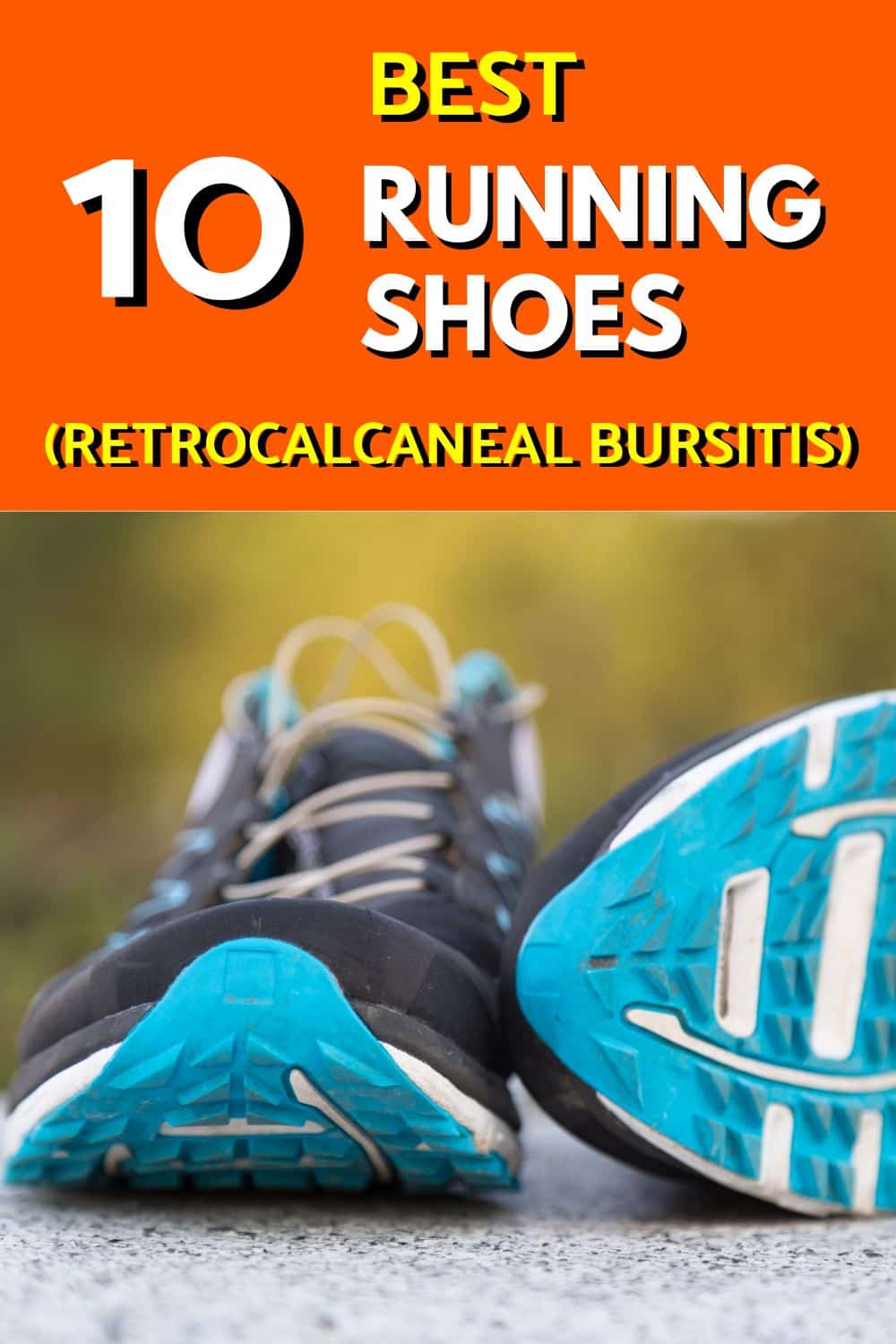

Madhusree Basu (Author, Admin)
Blogger and a fitness enthusiast. She loves running and Yoga and everything in between. She started running to manage her weight and to eat to her heart’s content. A true foodie at heart she shares whatever knowledge she has gained throughout the years about weight management and fitness.

Related Articles…
Salomon Vs Nike Sizing: How Different Are They?
Rowing Vs Running Vs Cycling: Which One Is Better For You?
Hoka Vs Nike: Which Brand Is Right For You?
Saucony Vs Asics Sizing Chart: How Are They Different?
Topo Vs Altra Sizing Chart: How Different Are They?
Brooks Vs Saucony Vs Hoka: Which Brand Is Right For You?
Hoka Vs New Balance: Which Brand Is Right For You?
New Balance Size Chart Vs Nike
10 Best Running Shoes For Ingrown Toenails (Highly Rated)

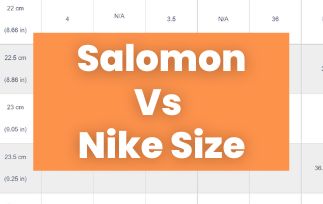
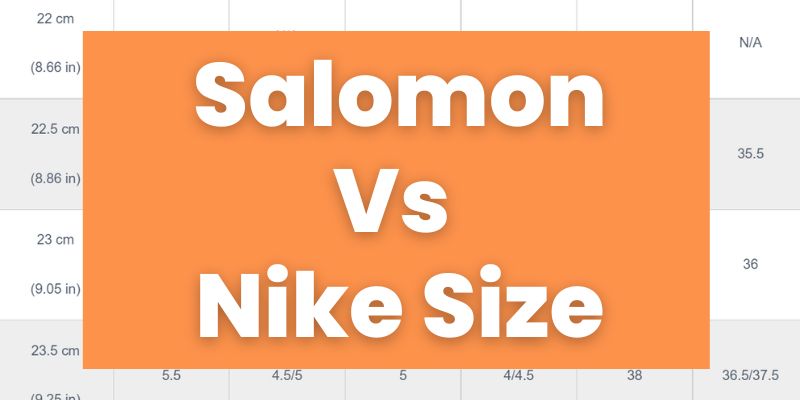

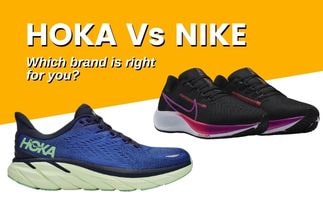

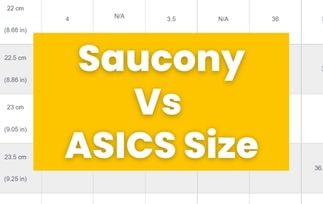

![10 Best 5mm Drop Running Shoes [2022]](https://bestplaygear.com/wp-content/uploads/2022/06/Best-5mm-heel-drop-running-shoes-min.jpg)

